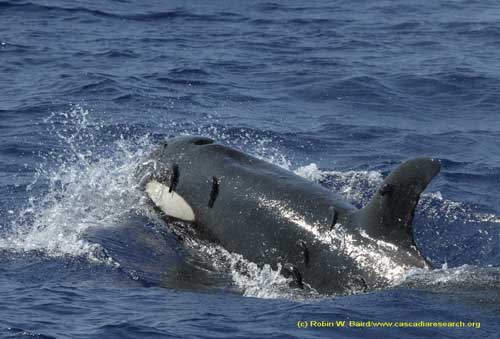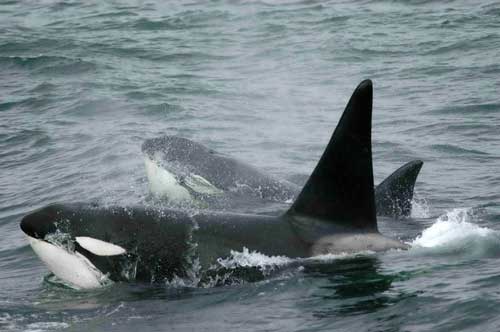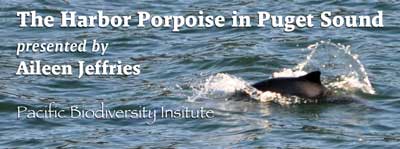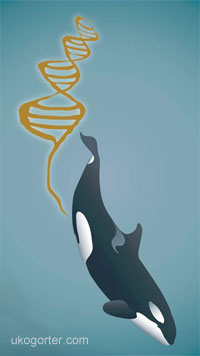2013-2014 Speaker Series
The Puget Sound Chapter of the American Cetacean Society would like to sincerely thank the following people for giving a presentation at one of our monthly Speaker Series meetings.
Click on any of the Abstract links for a summary and a brief bio about the talk Many abstracts also contain additional related resources.
18 June 2014 - Dawn Noren, NWFSC/NOAA
Endangered Southern Resident Killer Whales: 10 Years of Research and Recovery Efforts Abstract
In the early 2000s, citizens and researchers in Puget Sound were growing increasingly concerned about the health of the local killer whale population following a decline in the 1990s. In 2003, thanks to Congressional funding, NOAA began a research and conservation program to better understand and protect these animals. This talk will highlight results from research that has investigated risk factors and data gaps associated with the Southern Resident killer whale population as well as how the results are critical to informing management actions. Studies conducted by NOAA, collaborators, and partners over the past 10 years as well as areas of current and future research will be discussed.
Dr. Dawn Noren is a physiological ecologist whose primary research interests include: 1) energetics and metabolism, 2) assessment of body condition, 3) diving physiology, and 4) anthropogenic impacts. Dawn joined the Northwest Fisheries Science Center in May of 2003. Previously, Dawn was a National Research Council (NRC) Postdoctoral Research Associate at the National Marine Mammal Laboratory at the NOAA NMFS Alaska Fisheries Science Center, Seattle, WA, where she conducted research on Steller sea lion juvenile body condition, fasting physiology, and diving. Dawn received a Ph.D. in Ecology and Evolutionary Biology from the University of California, Santa Cruz. Her dissertation focused on elephant seal body condition, thermoregulation, and fasting physiology. She also earned an M.S. in Marine Sciences from the University of California, Santa Cruz. For her master's thesis, she investigated the physiology of diving and thermoregulation in bottlenose dolphins. Dawn earned her B.S. in Biological Sciences with and emphasis in Marine Sciences from the University of Maryland. Dawn's current research includes killer whale energetics and prey requirements, impacts of vessel presence on Southern Resident killer whale behavior and energetics, cetacean diving physiology, and contaminant transfer dynamics in delphinids.
21 May 2014 - Donna D.W. Hauser, School of Aquatic & Fishery Sciences, University of Washington
Studying beluga whales in a changing Pacific Arctic: distribution, migration, and diving behavior Abstract
Arctic marine ecosystems are at the epicenter of some of the most prominent signals of global climate change, with unprecedented rates of seasonal ice loss occurring over broad spatial scales. For the beluga whale (Delphinapterus leucas), a wide-ranging distribution and diverse diet may help buffer the species against climate impacts. However, populations have a propensity to migrate annually to maternally-driven summering areas that could be subjected to localized impacts. Two beluga populations in the Pacific Arctic, the eastern Chukchi Sea and Beaufort Sea, are known to migrate across hundreds of kilometers of Arctic habitat and range into >90% ice cover yet the degree of inter-population overlap and drivers behind their spatial distribution are not clear. In this talk I discuss work that is seeking to use locations and dive characteristics of satellite-tracked whales to quantify spatial and temporal distribution patterns as well as regional diving behavior. I will present an overview of physical changes occurring in the Arctic, before discussing results from telemetry data that provide insights into contemporary distribution, migration, and diving behavior of these beluga populations in the Pacific Arctic. It is currently unknown how distribution and migration will change for these populations in the context of climate change, and this research provides a baseline for further investigations of two populations increasingly exposed to physical and anthropogenic influences.
Donna D.W. Hauser is a PhD Candidate at the University of Washington’s School of Aquatic & Fishery Sciences. Donna has been involved in marine mammal ecology research for over 15 yr, including completion of a MS degree on Southern Resident killer whales in 2007. Missing active research since then, she returned to graduate school after several years working for a number of government agencies, non-profits, and in environmental consulting. Together with her adviser, Kristin Laidre, and collaborators at the North Slope Borough (AK) and Fisheries & Oceans Canada, Donna is tapping into a dataset of tagged beluga whales spanning over 20 years, two populations, and >65 tagged whales. One trip to the Arctic was all it took to get Donna hooked on Arctic marine ecology, and much of her current interests revolve around understanding the potential implications of a rapidly changing ecosystem on top marine predators. You can contact Donna via the School of Aquatic & Fishery Sciences, University of Washington, Box 355020, Seattle, WA 98195 USA.
16 April 2014 - Dr. Glenn Gailey, Cascadia Research Collective
Understanding, Monitoring and Mitigating Anthropogenic Impacts on a Critically Endangered Gray Whale Population off Sakhalin Island, Russia Abstract

The western gray whale population is one of the most critically endangered baleen whale populations in the world. In close proximity to their only known feeding grounds off northeastern Sakhalin Island, Russia, an escalating amount of anthropogenic activity has occurred over the past decade due to oil and gas exploration and development. To minimize potential disturbance to this population of gray whales, several monitoring programs were established to better understand the population dynamics, foraging/behavioral ecology, and abundance and distribution of these animals. This presentation will summarize our current knowledge of this endangered population of whales and highlight the evolution of mitigation and monitoring strategies with an increasing amount of knowledge about the animals and impact assessments on numerous activities over the past decade.
Dr. Gailey is a researcher at Cascadia Research Collective in Olympia. His research focuses on understanding behavioral ecology of cetaceans as well as identifying anthropogenic factors that may influence these behaviors. He has gained and applied his knowledge to a variety of different cetacean species in equally diverse habitats around the world. He is currently focused on behavioral impacts related to Indo-pacific humpback dolphins in Hong Kong, western gray whales in Russia, and Controlled Exposure Experiments on marine mammals to better understand behavioral responses to sound. He has also designed and developed several of the latest scientific software tools that facilitate data processing, visualization, management and analyses for research techniques such as photo-identification, theodolite tracking and passive acoustic monitoring.
19 March 2014 - Double Feature!
Film: Franciscana (La Plata river dolphin) On the Brink of Survival, preceeded by an introduction to the Soundside Marinelife Rescue Center by Casey Mclean Abstract

7:30-8 PM: Casey Mclean, Soundside Marinelife Rescue Center
An Introduction
Soundside Marinelife Rescue Center is a local 501c3 nonprofit working to establish Washington's first Marine Animal Hospital. Every year hundreds of marine animals strand on our shores and many do not have suitable options for care. Some of the problems they face can be traced to human interaction or pollution, and as our population increases more human interaction cases are seen. The public outcry for help for these animals is becoming louder and well-meaning citizens sometimes take matters into their own hands. Currently we rely on two organizations that are capable of only helping a very small percentage of the marine animals in need of rehabilitation. Soundside is working to remedy the problem by building a hospital that can not only rehabilitate marine mammals and birds, but also provide public education and support research. Soundside's President, Casey Mclean, will introduce you to the organization and expand upon their mission and goals to help marine mammals throughout the state of Washington.
8-9 PM: Franciscana (La Plata river dolphin) On the Brink of Survival
Film documentary, Portugese with English subtitles. (61 min)
Presented by the Brazilian conservation group, Projeto Toninhas (Project Franciscana), this unique documentary highlights the biology, research, and conservation efforts on behalf of one of this most endangered dolphin species off South America. It is the most comprehensive film documentary of the franciscana (Pontoporia blainvillei) every produced.
To produce the video documentary, the team traveled to the various regions within the range of the franciscana, from the Espírito Santo in Brazil, down to Northern Patagonia in Argentina. Filming was done between February 2011 and July 2012, with over 200 hours of recording, traveling more than 80 days and conducting more than 90 interviews.
The aim was to produce unique images of the franciscana in its natural habitat; the ongoing research; and the threats that directly affect this species. As a highly coastal species, its plight echoes the problems faced by the entire coastal ecosystem. Fisheries interactions (entanglements), pollution through chemical toxins, habitat degradation, and ocean noise, are some of the main issues threatening this smallest of all cetaceans. Interviews with fishermen, researchers, and managers of protected areas lend their voices as stakeholders of a marine environment that is shared by all.
Produced by Mundo Marinho. Sponsored by Petrobras through Petrobras Environmental Program.
19 February 2014 - Uko Gorter, Natural History Illustrator
Whales as a source of raw materials: A look at historic and recent whale products Abstract

The lure of hunting whales in the past can be explained when we consider the high value placed on the raw materials that could be extracted from them. While in earlier times the whales were stripped of blubber and whalebone (baleen), and the rest of the carcass discarded at sea, technological advances in the twentieth century made it possible to utilize the entire whale. From whalebone corsets to spermaceti candles, from military explosives to cattle feed, we'll take a closer look at the extensive and strange variety of whale products derived from these leviathans. We will have a sizeable collection of historic and recent whale products on hand (which you may touch), each with their own interesting and disturbing story.
Born in Arnhem, Holland, Uko Gorter is a scientific and natural history illustrator, specializing in marine mammals and marine fauna. Uko joined the American Cetacean Society in 2001, and is the president of the Puget Sound Chapter.
15 January 2014 - Robin Baird, Cascadia Research Collective
Hawai i's resident and not-so-resident Blackfish: recent studies of false killer whales and killer whales in Hawai i Abstract

There are two top predators in the marine environment in Hawaii, both of which are very rare, the false killer whale, which cooperatively hunts for large pelagic fish like tuna and swordfish, and the killer whale, which feeds on sharks, dolphins, squid, and other whales. One of these is resident to the islands, one only passes through the area, and one of them was listed as Endangered in 2012, the most recent species of whale listed under the Endangered Species Act. This presentation will summarize what is known about both species in Hawaiian waters including recent results from tagging and photo-identification.
Robin Baird is a research biologist with Cascadia Research Collective, based in Olympia. Although still dabbling with work on killer whales in the Pacific Northwest, most of his research for the last 14 years has been focused on toothed whales and dolphins in Hawaiian waters. He is also a member of the Committee of Scientific Advisors of the U.S. Marine Mammal Commission, an adjunct faculty at Hawaii Pacific University and the University of Washington, and a member of the false killer whale Take Reduction Team.
20 November 2013 - Dr. Paul Wade, NMML/AFSC/NOAA
New insights into Bigg's (transient-type) killer whales from the western Aleutian Islands -- a squid-eating separate species of killer whale? Abstract

Recent studies using whole mitochondrial genomes indicate transient-type killer whales in the North Pacific have been separated from other killer whales for hundreds of thousands of years, and may represent a separate species, to go along with the multiple species identified in the Antarctic. In addition, our studies in the Aleutian Islands have identified significant population structure within Bigg's killer whales, and field observations, satellite tagging and stable isotope studies suggest whales in the western Aleutians may eat a substantial amount of squid in addition to marine mammals.
Dr. Wade is a research fisheries biologist in the Cetacean Program (http://www.afsc.noaa.gov/nmml/cetacean/) at the National Marine Mammal Laboratory, Alaska Fisheries Science Center, NOAA Fisheries, in Seattle, Washington. He is also an Affiliate Professor at the School of Fisheries and Aquatic Sciences at the University of Washington. He has conducted population and ecological research on gray, bowhead, right, humpback and false killer whales, and on spotted, spinner, striped, and common dolphins.
Since 2001 his field research has focused on killer whales in the Aleutian Islands and Bering Sea. He is a member of the U.S. delegation to the Scientific Committee of the International Whaling Commission, the Cetacean Specialist Group of the IUCN Species Survival Commission, and the Steering Committee of the SPLASH North Pacific humpback whale project (http://hawaiihumpbackwhale.noaa.gov/science/splashinfo.html). He has published over 70 peer-reviewed papers, and over 50 additional non peer-reviewed scientific documents.
16 October 2013 - Aleen Jeffries, Pacific Biodiversity Institute
The Harbor Porpoise in Puget Sound Abstract

In the 1940s and 50s, the harbor porpoise (Phocoena phocoena) was an abundant cetacean in the Salish Sea. By the 1990s, its numbers and range had shrunk to the point that it was rarely seen south of Admiralty Inlet. At the present time, a number of anecdotal sightings may indicate that the species is recovering, but very little is known about its population trends. While there is no federal listing for the harbor porpoise, the Washington Department of Fish and Wildlife has designated the harbor porpoise a State Candidate Species. Canada has designated the harbor porpoise a Species of Special Concern, recognizing that it is particularly vulnerable to human activities. Aileen Jeffries, a Pacific Biodiversity Institute (PBI) board member, initiated a project to monitor the harbor porpoise population and trends in the Salish Sea in 2008. The long-term goal of this project is to set a baseline for the population that can be used to realistically assess the stability of the species. Another goal of the project is to investigate if the harbor porpoise is a sentinel species in the Salish Sea. Aileen has been using land-based observations and acoustic monitors to try to understand this cryptic species. She will present data from her studies and discuss what she is learning. Her research project is testing and calibrating acoustic monitors as a new tool for population assessment for the harbor porpoise.
Aileen Jeffries retired from a long career as a research physicist and has enjoyed transferring her skills to acoustics for studying the harbor porpoise. Pacific Biodiversity Institute is a non-profit organization dedicated to using the best available science to enhance natural resource planning and management decisions.
18 September 2013 - Jennifer Hempelmann, NWFSC
Paternity and Male Reproductive Success in the Southern Resident Killer Whale Population (SRKW) Abstract

Jennifer will give an overview of the breeding structure of the SRKW population, including an update of the family tree with the latest paternity assignments and parentage results of deceased neonate calves.
Jennifer Hempelmann is a molecular geneticist working at NOAA's Northwest Fisheries Science Center in Seattle. Her scientific background includes a degree in Zoology from the University of Washington and genetic research on rockfish populations. Since 2005, she has worked with marine mammal scientists to study the diet and population structure of the endangered Southern Resident killer whales by analyzing DNA found in whale scat and skin samples.

